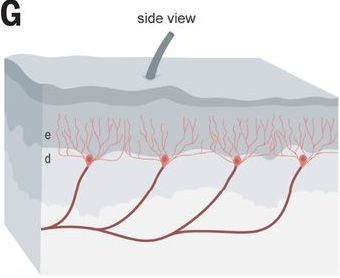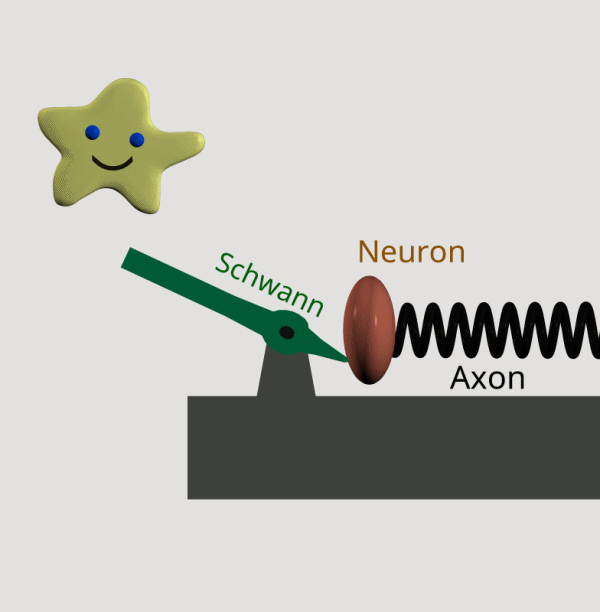Sunday, August 18, 2019
More glial gladness
Via ScienceDaily, another BIG finding about how the nervous system works.
After neurologists took off their theory goggles 20 years ago, all sorts of strange and wondrous things started to appear.
Theory said that the glia were just 'glue' and packing material between neurons. No reason to look for functions in styrofoam peanuts.
It turns out that the glial cells do a lot MORE than neurons. Some of them maintain and clean up neurons. Some of them build new neurons. Some are gardeners, pruning unproductive neurons.
And some perform part of the sensing task.
This new finding truly DISRUPTS our understanding of the sense of touch.
The abstract is sparse, so I paid $30 for the whole article. Most of the text describes the gene-splicing methodology of the measurement, which is way over my head. If there's anything dramatic in those parts, I wouldn't know it.
The parts about electrical function are within my ken, and there's plenty dramatic in those parts.

 Question: Are all the senses made this way, with glia serving as the high-pass or low-pass filters and rectifiers and lenses, and neurons serving as the raw sensor? It's certainly true in the retina where glial cells filter and focus specific colors onto the retinal sensors. This setup hasn't been seen yet in the cochlea, but I wouldn't be surprised if it appears. Deiters Cells, though not classed as glia, surround the hair cells in a similar net-like way, with projections from one hair cell to the next.
Question: Are all the senses made this way, with glia serving as the high-pass or low-pass filters and rectifiers and lenses, and neurons serving as the raw sensor? It's certainly true in the retina where glial cells filter and focus specific colors onto the retinal sensors. This setup hasn't been seen yet in the cochlea, but I wouldn't be surprised if it appears. Deiters Cells, though not classed as glia, surround the hair cells in a similar net-like way, with projections from one hair cell to the next.
We provide evidence for a specialized glial cell type that builds a sensory organ in the skin, initiating the sensation of pain. The nociceptive Schwann cells display a mesh-like network of cytoplasmic sheaths around nerves in the subepidermal border with radial processes entering into the epidermis abutting to unmyelinated nociceptive nerves.The Schwann cells form a mesh, with connections to neurons.

They transduce nociceptive stimuli into electrical signals that translate into [pain responses by the mouse]. The nociceptive nerve endings in skin also gate responses to various noxious stimuli. Hence, nociceptive nerves and nociceptive Schwann cells form a nociceptive glio-neural complex with two sensor-receptor cell types, the glia and the nerve, both likely influencing the sensation of pain. Both response and adaptation were very rapid, resulting in similar responses in the subsequent stimuli. The cells tracked the maximum frequency of stimuli that we could generate (60 Hz). Releasing the force also depolarized the cells. Thus, nociceptive Schwann cells responded to both positive and negative changes in force but much less to sustained force.So the glial cells are acting as two-way triggers for the neurons, telling the neurons when something has happened. When something pushes on the skin or something pulls away, it's time for the neuron to wake up and do its particular thing.
 Question: Are all the senses made this way, with glia serving as the high-pass or low-pass filters and rectifiers and lenses, and neurons serving as the raw sensor? It's certainly true in the retina where glial cells filter and focus specific colors onto the retinal sensors. This setup hasn't been seen yet in the cochlea, but I wouldn't be surprised if it appears. Deiters Cells, though not classed as glia, surround the hair cells in a similar net-like way, with projections from one hair cell to the next.
Question: Are all the senses made this way, with glia serving as the high-pass or low-pass filters and rectifiers and lenses, and neurons serving as the raw sensor? It's certainly true in the retina where glial cells filter and focus specific colors onto the retinal sensors. This setup hasn't been seen yet in the cochlea, but I wouldn't be surprised if it appears. Deiters Cells, though not classed as glia, surround the hair cells in a similar net-like way, with projections from one hair cell to the next.Labels: Asked and partly answered, Carver, Grand Blueprint
